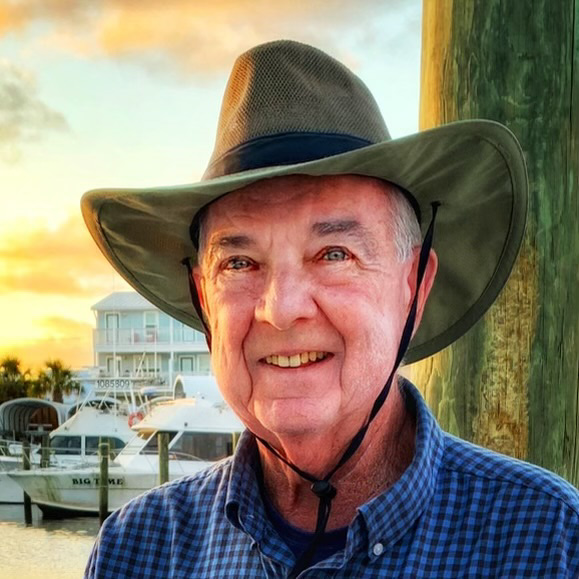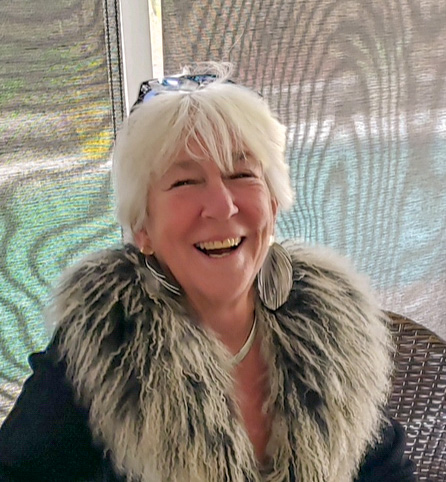‘Pay attention to what’s on your skin’
Free cancer screenings available next week
Danny Stovall, now of Wewahitchka, was just a barefoot kid running around Douglas County, Georgia, eight miles from the nearest paved road, his favorite pastime hitting rocks with a broomstick handle, when he first developed a noticeable problem with his skin.
“We had no TV so I rambled around all the time outside,” said Stovall, now 83 and retired from 40 years as a choral director as part of his music ministry in Baptist churches.
“I’d hit rocks,” he said. “I was going to be a big major league ballplayer in my mind.”
At age 18, in 1958, he saw a growth had started under his left eye, and it became irritable looking, so he went to the drug store and asked for salve.
“The pharmacist said ‘You need to have that looked at,’ and I went to the local doctor,” Stovall said. “The doctor took it out and said it developed at less than 10 years of age.

“Then I got a letter saying it was cancerous, and it scared me to death,” he said. “The letter didn’t explain anything; it had just one word – cancer. It scared the heck out of me.”
A thorough analysis revealed Stovall had developed a basal cell carcinoma. He would go 12 more years before his next one appeared, and that was removed by a doctor in Atlanta by a freezing technique, once again without requiring stitches.
“I’ve had more than 25 taken off of me,” he said, several by Angela Mercer, a certified physician assistant with Dermatology Specialists of Florida, which as of Monday, has expanded its practice in Port St. Joe from three to five days a week.
In the case of Deb Berry, of St. Joe Beach, she was age 50 at the family’s house on Lewis Smith Lake in north Alabama, frolicking with her five dogs, when she first noticed an odd-looking spot around her shin that just wouldn’t heal.
So she went to a dermatologist who she happened to have bought a house from and he had her immediately cancel a planned trip to Hawaii, and schedule the surgical removal of what turned out to be her first squamous cell carcinoma.
Since that time, she’s had about 40 of these cancerous, or potentially cancerous, lesions removed, “around the same number of dogs I’ve had in my life,” said Berry.
“I go to Angela here pretty often,” she said. “They can burn or freeze them so it doesn’t get far enough along for me to require surgery.”
Mercer, who earned a master of science in physician assistant studies from South University in Savannah, Georgia after studying at the University of Pittsburgh, has worked in the Transplant Center at the Mayo Clinic in Jacksonville, the emergency department at Capital Regional Medical Center in Tallahassee, and another Florida dermatology practice.

She assists the physician team with Mohs surgery, treating precancerous lesions, providing comprehensive skin exams as well as diagnosing and treating general dermatological conditions. She is also skilled in the use of laser treatments for tattoo removal, scar revision and skin resurfacing.
Berry said while most of her lesions were handled in Port St. Joe, she has had occasion to undergo the Mohs surgery in Panama City.
“You have to pay attention to what’s on your skin,” she said. “Pay attention and get somebody to look at it. It may turn out to be nothing but if you wait, it can be a little time consuming. The one on my face, four years ago, I had the stitches, but you can’t even see the scar,” Berry said.
“As I’ve gotten older, I’ve gotten better at picking them out,” she said. “It looks like a hard flaky bump on the skin and if you bother it, it will not heal. Or like little bitty tiny whiteheads, not like a bug bite and not a rosebush prick, but they’ll start itching.”
Now retired from accounting, Berry remains active at VFW Auxiliary Post #10069 in Port St. Joe, and enjoys volunteer work as well as music and dancing for fun and exercise. And Stovall loves to go out fishing.
The one thing they have in common, now that they’ve had brushes with skin cancers, is they each make sure to wear strong sunscreens outdoors, with an SPF of at least 30, and have cut back on their time spent outdoors in the direct sunlight.
“When I’m working in the yard I put sunscreen on my face and neck and wear a hat with a broad brim on it,” said Stovall.
“I usually wear a visor, and don’t go to the beach or pool near as often as I used to,” said Berry. “Sunscreen is your friend. I usually put it on every day, and I pretty much stay out of the sun in the hot part of the day now.”
Dermatology Specialists is hosting free skin cancer screenings throughout May, recognized as Skin Cancer Awareness Month. Over 30 free screening events will be held throughout Florida, Georgia, Alabama and Mississippi to help detect skin cancer early in adults who have not had a professional skin cancer screening within the past year.
One in five Americans will develop skin cancer at some point in their lifetime – the most common types being basal cell carcinoma and squamous cell carcinoma. While less common, an estimated 200,000+ cases of melanoma, a more dangerous skin cancer due to its tendency to spread, will be diagnosed in the U.S. in 2024. In fact, more than 2 people die of skin cancer (mostly melanoma) in the US every hour. Despite these staggering statistics, skin cancer is one of the most preventable cancers, highly curable when caught and treated early.
“Unlike other cancers, skin cancer can be seen on the surface of your skin,” said Dr. Jon Ward, board-certified dermatologist and practice founder. “A skin cancer screening from a dermatologist is a visual exam that is painless, only takes a few minutes, and could save your life.” Visit mydermspecialists.com/freescreening to see the full list of participating locations and dates. Appointments are required; call (877) 231-3376 to schedule.
At a glance
• Research estimates that nonmelanoma skin cancer, including basal cell carcinoma and squamous cell carcinoma, affects more than 3 million Americans a year.
• Women had a greater increase in incidence than men for both types of nonmelanoma skin cancer.
• Risk factors for all types of skin cancer include skin that burns easily; blonde or red hair; a history of excessive sun exposure, including sunburns; tanning bed use; a weakened immune system; and a history of skin cancer.
• Skin cancer warning signs include changes in size, shape, or color of a mole or other skin lesion, the appearance of a new growth on the skin, or a sore that doesn’t heal.
• Melanoma rates in the United States have been rising rapidly over the past 30 years — doubling from 1982 to 2011 — but trends within the past decade vary by age.
• Skin cancer can affect anyone, regardless of skin color.
• The incidence of skin cancer among non-Hispanic White individuals is almost 30 times higher than that among non-Hispanic Black or Asian/Pacific Islander individuals.
• Skin cancer in patients with darker skin tones is often diagnosed in its later stages, when it’s more difficult to treat.
• Research has shown that patients with darker skin tones are less likely than patients with lighter skin tones to survive melanoma.
• The five-year survival rate for people whose melanoma is detected and treated before it spreads to the lymph nodes is 99%.
• Excess exposure to UV radiation from sunlight or use of indoor tanning also increases risk for all skin cancer types, as does a personal history of the disease.
• Sunburns during childhood or adolescence can increase the odds of developing melanoma later in life.


Meet the Editor
David Adlerstein, The Apalachicola Times’ digital editor, started with the news outlet in January 2002 as a reporter.
Prior to then, David Adlerstein began as a newspaperman with a small Boston weekly, after graduating magna cum laude from Brandeis University in Waltham, Massachusetts. He later edited the weekly Bellville Times, and as business reporter for the daily Marion Star, both not far from his hometown of Columbus, Ohio.
In 1995, he moved to South Florida, and worked as a business reporter and editor of Medical Business newspaper. In Jan. 2002, he began with the Apalachicola Times, first as reporter and later as editor, and in Oct. 2020, also began editing the Port St. Joe Star.